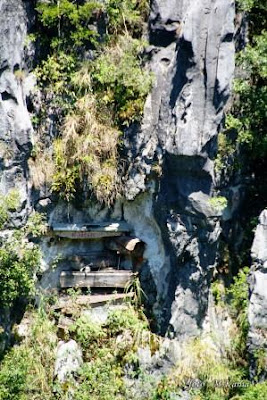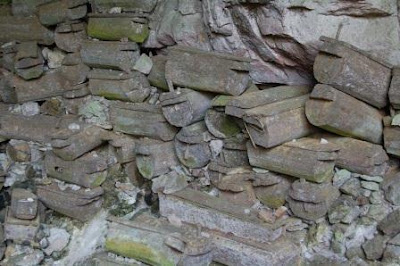Region Sagada, na
wyspie Luzon, słynie z „wiszących trumien.” To tradycyjna metoda pochówku
zmarłych, która praktykowana jest od 2000 lat, aż do dziś, przez nieliczne
lokalne plemiona (Igorot i Appla). Tamtejsi ludzie wierzą, że zmarły pochowany
w ten sposób, wysoko nad ziemią, wiszący na skale lub złożony w górskiej
jaskini, ma „bliżej do nieba.”
Rytuał pogrzebowy
zaczyna się jeszcze za życia osoby. Dlatego też, trumny zwykle robione są
samodzielnie przez starszych ludzi, po to, aby tam być złożonym po śmierci.
Rzeźbione są one z jednego pnia drzewa. Jeżeli ta osoba jest zbyt słaba lub
chora, pomaga jej syn lub ktoś z rodziny. Po śmierci ciało dosłownie „wpycha
sie do środka,” gdyż trumny takie są zwykle wąskie w środku.
Innym ważnym
zwyczajem takiego tradycyjnego pochówku jest to, że ciało powinno być
umieszczone w trumnie w pozycji pre-natalnej. Ludzie wierzą, że człowiek
powinnien „schodzić” z tego świata w takiej samej pozycji jak tu przyszedł.
Dlaczego wiesza
się trumny w Sagada? Po pierwsze, aby uchronić ciała zmarłych przed złodziejami
i dzikimi zwierzętami, i jakimkolwiek innym znieważeniem. Po drugie, miejscowi
ludzie wierzą, że duszy jest łatwiej "wędrować do nieba" z tej pozycji, niż z
ziemi, gdzieś tam głęboko zakopanej.
 Sagada is famous for its "hanging coffins". This
is a traditional way of burying people that is still practice by some of the
local tribes. The Igorot and Appla ancestors in Sagada believed that the higher
your body is laid – the close they are to ‘heaven’. Hanging coffins lie on
beams projecting outward from vertical faces such as mountains, are placed in
caves in the face of cliffs, or sit on natural rock projections on mountain faces.
Sagada is famous for its "hanging coffins". This
is a traditional way of burying people that is still practice by some of the
local tribes. The Igorot and Appla ancestors in Sagada believed that the higher
your body is laid – the close they are to ‘heaven’. Hanging coffins lie on
beams projecting outward from vertical faces such as mountains, are placed in
caves in the face of cliffs, or sit on natural rock projections on mountain faces.
These coffins are carved by the elderly before they die; if
they are too ill or weak their son or other close relative will do it for them.
This ritual involves pushing the bodies into the tight spaces of the coffins,
and often bones are cracked and broken as the process is completed.
After the deceased are put inside these coffins they are
then brought to caves high in the cliffs where they join the coffins of other
ancestors. The Segada people prefer to be buried in the cliffs than to be
buried in the ground and have been doing this for more than 2,000 years.
Some noticed that the coffins are fairly small, that is
because the body is placed in the fetal position. They believe that people
should pass through this world the same way they got in. Some of the graves
have chairs. These are ‘death chairs,’ where the dead were left sitting for a
while before the funeral. People would not use them so they hang them alone
with the coffins.
As to why they are placed high on the cliffs? One reason is
to avoid animal scavengers desecrating the body or thieves stealing their
belongings. The other reason is that
they believe that the spirit would rise up easier from here than being buried
six feet underground.
 |
| Beauty of Sagada |
 |
| Local boys |
 |
| On the way to Sagada. 10 h by bus from Manila |












Brak komentarzy:
Prześlij komentarz